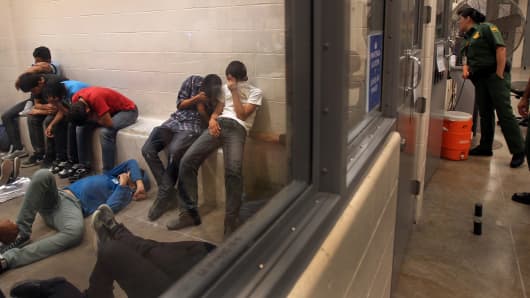1. No immediate deportations of unaccompanied minors from Central America. In 2008, a bipartisan law signed by President George W. Bush required that unaccompanied minors seized at the border (except those from Mexico or Canada) cannot be deported to their home country without a full immigration hearing. Children from Mexico and Canada, on the other hand, can be subject to "voluntary repatriation" within 72 hours of their capture, so long as an immigration officer finds that they were not the subject of a "severe form of trafficking in persons" and do not have a basis to claim asylum.
Read MoreObama: We now have a humanitarian crisis
Under the law, within 72 hours of their capture, children from Central America must be transferred from immigration detention to the custody of the Department of Health & Human Services. The law further requires that the child be "promptly placed in the least restrictive setting that is in the best interest of the child" by HHS. Any child not released from HHS custody must receive a new hearing "at least monthly." As a result, children are frequently placed into the custody of family members already in the United States, pending their immigration hearing.
Because the immigration-hearing system has been overwhelmed by the number of deportations sought, children often spend years with their families before they ever see an immigration judge. During that time, they are free from the dangers of living in their home countries and entitled to free public education in the United States.
During 2008, when the law was adopted, there were fewer than 5,000 unaccompanied minors captured at the border. The law reflected the belief that unaccompanied children (not from Mexico or Canada) likely were the victims of alien traffickers, who might seek to exploit the children as slaves or prostitutes. Children from Mexico and Canada were treated differently, because Congress could imagine a stampede of children from those neighboring countries. Congress did not foresee that Central American families might voluntarily send unaccompanied children en masse to the border.
2. Mass deportations of gang members. Over the past two decades, the United States has deported thousands of gang members to El Salvador, Honduras and Guatemala. Any alien convicted of a crime faces mandatory deportation from the United States, even if that alien has lived in the United States. Thousands of members of Central American gangs, such as the infamous El Salvadorian gang MS-13, were deported. Politicians from all parties were united in their fervor to expel criminal aliens immediately upon the end of their prison sentences.
Read MoreForget amnesty; job reform can solve our immigration crisis
The United States gang culture has taken over vast portions of El Salvador, Guatemala and (to a lesser degree) Honduras. Deported gang members do not become peaceful in their home countries, but rather continue to be dangerous criminals in a society ill-equipped to deal with them. The murder rates have soared in El Salvador, Guatemala and Honduras as the gangs have fought for control of cities and the hinterlands. For example, more than 1,000 people under the age of 23 were murdered last year in Honduras, a country of 8 million people.
Families in these countries are desperate to send their children away from the killing fields of gang violence. They are willing to entrust young children to alien traffickers, who promise that the children will be allowed to stay in the United States once they arrive at the border.
3. Hope for comprehensive immigration reform. The expectation of comprehensive immigration reform has emboldened undocumented aliens living in the United States to seek reunification with children they left behind in Central America. In 2013, comprehensive immigration reform passed the United States Senate, raising hopes of undocumented aliens that they would have a "path to citizenship." Parents who previously left children behind with grandparents or other extended family to have their children join them.
4. Required public education for undocumented alien children. In 1981, the United States Supreme Court held in a case named Plyler v. Doe that states must provide public education to undocumented alien children to the same extent they provide public education to citizens.
"If the State is to deny a discrete group of innocent children the free public education that it offers to other children residing within its borders, that denial must be justified by a showing that it furthers some substantial state interest. No such showing was made here."
Read MoreAdelson, Buffett, Gates call for immigration reform
This ruling places enormous strains on the educational system of border communities where undocumented alien children reside while they await deportation hearings. It also provides undocumented alien parents with the knowledge that their children will be educated during their time in the United States.
A solution is going to require the same bipartisan cooperation that created the problem.
To resolve this crisis, Democrats and Republicans will have to come to an agreement on the changes to the law. The Obama Administration's request for $3.7 billion in emergency funding, largely to deal with the care of the children and expedited hearings on their deportations, has not been warmly received by the Republican-led House of Representatives. Democrats have rejected the proposal from Republicans that children from all countries be subjected to rules that apply to children from Mexico, which allow for immediate "voluntary repatriation" to the home country. Something must change, because the current law is acting as magnet, drawing thousands of children who take the dangerous journey from their home countries through Mexico and on to the United States.


